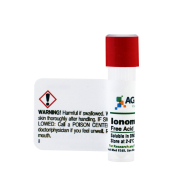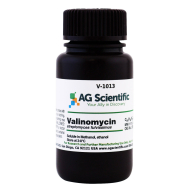The ionophores were first recognized as being a separate class with the publication of the structure for monensin in 1967. Several members of the group have found commercial application as anticoccidials in poultry farming and as growth promoters for cattle, pigs and chickens.
Polyether antibiotics are characterized by multiple tetrahydrofuran and tetrahydropyran rings connected by aliphatic bridges, direct C-C linkage, or spiro linkage. Other important features, also contributing to their mode of action include a free carboxyl function, many lower alkyl groups and a variety of functional oxygen groups. The ionophore antibiotics are fermentation products of various Streptomyces spp. (monensin, salinomycin) and Actinomadura spp. (maduramycin) and are active against both protozoa and bacteria. Consequently they are used as prophylactic and therapeutic anticoccidials and antibacterials and may also be used for growth promotion in cattle and swine.
Mode of Action
An ionophore is a lipid-soluble molecule usually synthesized by microorganisms to transport ions across the lipid bilayer of the cell membrane. Ionophores disrupt transmembrane ion concentration gradients, required for the proper functioning and survival of microorganisms, and thus have antibiotic properties. They are produced naturally by a variety of microbes and act as a defense against competing microbes. Many antibiotics, particularly the macrolide antibiotics, are ionophores that exhibit high affinities for Na+ or K+.
Antibacterial Activity
The ionophore antibiotics are generally extremely hydrophobic with a molecular weight greater than 500 daltons. Consequently they cannot penetrate the outer membrane of gram-negative bacteria and this group of organisms is generally ionophore resistant. In contrast, gram-positive organisms, lacking the protective outer membrane are susceptible. The ionophores are active against both aerobic and anaerobic gram-positive organisms including Lactobacillus spp., Eubacterium spp., Peptococcus spp., Peptostreptococcus spp., Streptococcus bovis, as well as Acholeplasma and Mycoplasma spp.Both salinomycin and monensin have been shown to suppress Clostridium perfringens and therefore they may be considered important in the prevention of necrotic enteritis in broiler chickens. It has been suggested that the antibacterial activity of ionophores may result in overgrowth of gram-negative organisms in the gut, particularly Salmonella spp. but evidence for this is conflicting. In ruminants ionophores can be used to manipulate rumen fermentation and hence ruminal volatile fatty acid concentrations. This effect is thought to be the basis for improved feed efficiency when low concentrations of ionophores are included in ruminant feeds.
The susceptibility of bacteria to the ionophore antibiotics varies depending on cell wall structure. The gram negative organisms are more inherently resistant due to the inability of the ionophores to penetrate the cell membrane, although within this group of organisms differences in ionophore binding and permeability have been observed. Gram positive organisms are more susceptible as a group because of their cell wall structure and again, within the group differences in susceptibility have been observed.
There is little data in the literature concerning resistance in pathogenic organisms important in human health and the effects of the ionophore antibiotics on the bacterial flora of the gut of pigs and chickens are not readily available. However some limited studies have been performed which indicate resistance occurring in the following groups of organisms. It has also suggested that cross resistance to other ionophores may be a common feature of resistance to individual compounds.



